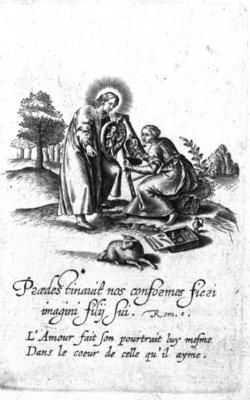Ludovicus van Leuven, Amoris divini et humani antipathia (1629)
Table of contents ↑Imago Amoris [57]

XV.
Rusbrochius.
Rusbroch.
SEcundum excellentissimam animæ nostræ por-
tionem, quæ est supremarū virium nostrarum
origo, ceu viuidum ac æternum factum sumus
speculum, cui is sempiternā suam impressit ima-
ginem, quodque nullam aliam vnquam recipere
imaginem potest. & hoc speculum diuino vultui
semper propositum manet, atque ea re cum ima-
gine quam suscepit, etiam ipsum sit æternum. in
hâc æternâ imagine, id est, in Filio, cognouit nos
Deus in seipso, & antequam creati essemus, &
nunc in tempore quando ad ipsum cōditi sumus.
Hæc imago in cunctis hominibus & essentia-
liter & personaliter inest, & singulis quisque to-
tam eam & integram ac indiuisam habet: nec ta-
men simul homines vniuersi plus inde, quam vnus
aliquis, habent. Atque hac ratione omnes nos v-
num sumus, vniti in æterno exemplari nostro,
quod est imago Dei & omnium nostrûm, & vitæ
& essentiæ nostræorigo, in quo creata essentia &
vita nostra sine medio, tāquam in causa sua æter-
na dependet: neque tamen vel ipsa creata essentia
nostra fit Deus, vel imago Dei fit creatura; nos
enim creati sumus ad imaginem, id est, vt Dei
imaginem suscipiamus.
SEcundum excellentissimam animæ nostræ por-
tionem, quæ est supremarū virium nostrarum
origo, ceu viuidum ac æternum factum sumus
speculum, cui is sempiternā suam impressit ima-
ginem, quodque nullam aliam vnquam recipere
imaginem potest. & hoc speculum diuino vultui
semper propositum manet, atque ea re cum ima-
gine quam suscepit, etiam ipsum sit æternum. in
hâc æternâ imagine, id est, in Filio, cognouit nos
Deus in seipso, & antequam creati essemus, &
nunc in tempore quando ad ipsum cōditi sumus.
Hæc imago in cunctis hominibus & essentia-
liter & personaliter inest, & singulis quisque to-
tam eam & integram ac indiuisam habet: nec ta-
men simul homines vniuersi plus inde, quam vnus
aliquis, habent. Atque hac ratione omnes nos v-
num sumus, vniti in æterno exemplari nostro,
quod est imago Dei & omnium nostrûm, & vitæ
& essentiæ nostræorigo, in quo creata essentia &
vita nostra sine medio, tāquam in causa sua æter-
na dependet: neque tamen vel ipsa creata essentia
nostra fit Deus, vel imago Dei fit creatura; nos
enim creati sumus ad imaginem, id est, vt Dei
imaginem suscipiamus.

Rusbrochius.
Pourtrait de l'Amour.
XV.
Ces deux amants, dont les cœurs & les ames
Sont deux pourtraits des reciproques flames,
De leurs pinceaux se paignent tour à tour,
Et ces tableaux sont des miroirs de glaçe,
Qui leur font voir leur mutuelle façe,
Et les effects de leur parfaict amour.
XV.
Ces deux amants, dont les cœurs & les ames
Sont deux pourtraits des reciproques flames,
De leurs pinceaux se paignent tour à tour,
Et ces tableaux sont des miroirs de glaçe,
Qui leur font voir leur mutuelle façe,
Et les effects de leur parfaict amour.
Translations
 |
Image of love. |
 |
He did predestinate us to be conformed to the image of his Son. |
Sources and parallels
-
Possibly based on, not mirrored, nimbus given to Christ and background landscape added, in: Imago amoris. [29]
 (in: anonymous, Amoris divini et humani antipathia (1628)
(in: anonymous, Amoris divini et humani antipathia (1628) )
[Compare
)
[Compare ]
]
References, across this site, to this page:
- Imago amoris. [29]
 (in: anonymous, Amoris divini et humani antipathia (1628)
(in: anonymous, Amoris divini et humani antipathia (1628) )
)

